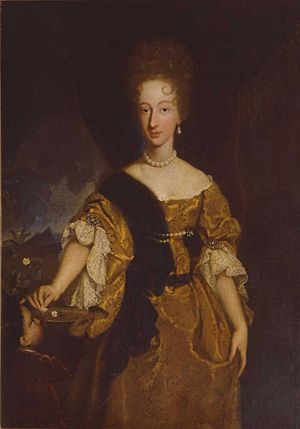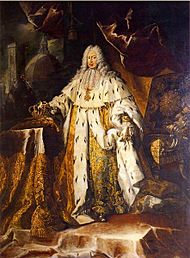Violante Beatrice of Bavaria facts for kids
Quick facts for kids Violante Beatrice of Bavaria |
|||||
|---|---|---|---|---|---|

Portrait by Niccolò Cassana
|
|||||
| Grand Princess of Tuscany | |||||
| Tenure | 9 January 1689 – 31 October 1713 | ||||
| Governor of Siena | |||||
| Tenure | 12 April 1717 – 30 May 1731 | ||||
| Born | 23 January 1673 Nymphenburg Palace, Munich, Bavaria |
||||
| Died | 30 May 1731 (aged 58) Palazzo Pitti, Florence, Tuscany |
||||
| Burial | Convent of Saint Teresa, Florence, Tuscany | ||||
| Spouse | Ferdinando de' Medici | ||||
|
|||||
| House | House of Wittelsbach House of Medici |
||||
| Father | Ferdinand Maria, Elector of Bavaria | ||||
| Mother | Henriette Adelaide of Savoy | ||||
Violante Beatrice of Bavaria (born January 23, 1673 – died May 30, 1731) was an important royal figure. She became the Grand Princess of Tuscany when she married Grand Prince Ferdinando of Tuscany. Later, she served as the Governor of Siena from 1717 until her death.
Violante Beatrice was born a Duchess of Bavaria. She was the youngest child of Elector Ferdinand Maria, who was a powerful ruler in Bavaria. In 1689, she married Ferdinando de' Medici, who was next in line to rule the Tuscan kingdom. Violante Beatrice cared for her husband, but he did not feel the same way.
Her brother-in-law, Prince Gian Gastone, became her friend. This friendship lasted throughout her life. After Grand Prince Ferdinando passed away in 1713, Violante Beatrice was left without children or a clear role in the Tuscan court.
When Electress Anna Maria Luisa, her sister-in-law, returned to Tuscany, Violante Beatrice thought about moving back to her brother's court in Munich. However, Gian Gastone convinced her to stay. The ruler at the time, Cosimo III, then made her the Governor of Siena. She lived there and helped organize the city. For example, in 1729, she officially set the borders and names for Siena's Contrade, which are like local neighborhoods.
During the rule of Grand Duke Gian Gastone, Violante Beatrice was in charge of official court meetings. She worked with Electress Anna Maria Luisa to try and get Gian Gastone to spend less time with his group of friends, called the Ruspanti. They organized parties and public events for him. But Gian Gastone preferred to stay in bed, entertained by his Ruspanti, for the last eight years of his rule.
Early Life and Marriage
Violante Beatrice was born on January 23, 1673, in Munich, the capital of Bavaria. She was the youngest child of Elector Ferdinand Maria of Bavaria and Henriette Adelaide of Savoy. Her older siblings included Maria Anna Victoria, who married the Dauphin of France, and Elector Maximilian II.
In 1688, Grand Duke Cosimo III of Tuscany was looking for a royal bride for his oldest son, Ferdinando. Bavaria was a very powerful state in the Holy Roman Empire, so Violante Beatrice was a good choice. There had been some money problems between Tuscany and Bavaria in the past. Cosimo III had to pay back money to Maximilian II, Ferdinand Maria's son, to make things right.
Once this was settled, the marriage agreement was signed on May 24, 1688. Violante Beatrice received a large dowry, which included money and jewelry. She first married Grand Prince Ferdinando in a ceremony where someone stood in for him in Munich on November 21, 1688. The actual wedding with Ferdinando took place on January 9, 1689. The wedding party was held at the Palazzo Medici Riccardi in Florence. Violante Beatrice was very happy with her new husband. Grand Duke Cosimo III was also pleased with her, saying she had a "perfect" personality.
Life as Grand Princess

After six years of marriage, the Grand Prince and Grand Princess still did not have children. This worried the Grand Duke. In April 1694, he ordered three days of special religious prayers to help them have children. This made Violante Beatrice feel sad.
Grand Prince Ferdinando passed away on October 31, 1713. This left Violante Beatrice as a widow without children, and she felt she had no purpose. She was very upset by his death. Cosimo III gave her beautiful blue sapphires to show his sympathy. Violante Beatrice thought about going back to her home country. This was because she heard that Electress Anna Maria Luisa, who was a Tuscan princess by birth, was coming back. The two women did not get along well.
To avoid arguments about who was more important, Cosimo III made Violante Beatrice the Governor of Siena. This job kept her busy and away from the Tuscan court. He also gave her the Villa di Lappeggi, a large country house. This villa became a place for writers and poets to gather. She hosted poets like Lucchesi, Ghivanizzi, and Morandi there. Even though rules were set to respect Violante Beatrice's position, the Electress sometimes ignored them. Because of this, Violante Beatrice refused to appear in public with her.
Governor of Siena

Violante Beatrice arrived in Siena in April 1717 and lived in the city center. Her most important action as Governor was organizing the Sienese Contrade. These are like different districts or neighborhoods in the city. She officially set their names, how many there were, and their boundaries. These rules are still used today.
Grand Duke Cosimo III died on October 31, 1723. Gian Gastone then became the new Grand Duke. He immediately called Violante Beatrice back to Florence. He also sent his sister, the Electress, to live at the Villa La Quiete. Violante Beatrice became very important at the royal court because Gian Gastone let her handle most of his public duties. He preferred to spend most of his time in bed.
The serious mood of Cosimo III's rule changed to a more lively time. Violante Beatrice brought French fashions to the court. She also encouraged many church officials to retire. She supported poets from Siena, like Perfetti and Ballati. In 1725, Violante Beatrice took Perfetti to Rome and stayed at the Palazzo Madama. While in the Papal States, she met Pope Benedict XIII. He liked her so much that he gave her the golden rose, a special honor from the Pope.
After returning from Rome, Violante Beatrice and Electress Anna Maria Luisa decided to try and improve Gian Gastone's public image. They also wanted to reduce the influence of his group of friends, the Ruspanti. To try and distract him, Violante Beatrice held banquets. She invited important people from Tuscan society to these parties. However, the Grand Duke's behavior often made guests want to leave quickly. The Electress had more success. She managed to get Gian Gastone to appear in public on Saint John the Baptist's day in 1729.
Violante Beatrice of Bavaria passed away just five months before troops arrived for Gian Gastone's Spanish heir. During her funeral procession, her carriage briefly stopped in front of the Pitti Palace. This made the Grand Duke angry, and he ordered the carriage to move on. Most of Violante Beatrice's remains were buried in the Convent of Saint Teresa in Florence. Her heart was placed in her husband's coffin in the Medici family burial place, San Lorenzo. In 1857, her coffin was found again. It had a stamp from Napoleon I of France, who had moved it from the convent to San Lorenzo. On February 26, 1858, she was returned to the convent in a royal carriage.
Images for kids
See also
 In Spanish: Violante Beatriz de Baviera para niños
In Spanish: Violante Beatriz de Baviera para niños



